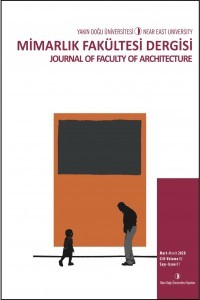Karizmatik Bir Figür olarak “Starchitect”
Mimarlık dünyasında zamanın şartları içinde,mimarın kendini var edebilmesi ya da bu dünyayı ele geçirme girişimleri Vitrivius’a kadar temellendirilebilir. Mimarın kişisel kabulleri veya karşı çıkışları sonuçta yaygın bir uygulama alanı bulup toplumsallaştığında, sonuç ürünlerin ortak noktası konulan kuralların aynılığı, kolay anlaşılabilmesi, benimsenebilmesi, yaygın bir mimarlık dilinin varlığını gündeme getirmektedir. Çoğunlukla bu mimari dil, sonuç ürünü yaratan mekanizmaları ve etkileşimleri tanımlar nitelikte olmakta, böylece yeni ağ ve bağlantıların algılanabilmesi kolaylaşmaktadır. Mimarlıkta olduğu gibi sanatın ve bilimin hemen her alanında, ortak dili oluşturan girdilerin, yaratıcı etkinliğin merkezinde yer aldığı da bilinmektedir. Bu çalışma kavramsal olarak mimarın çağlar boyunca, stratejik olarak oluşturduğu ortam içinde, kendini konumlandırdığı ve kabul ettirdiği statüsünün altını çizmeyi amaçlamaktadır. Çalışma kronolojik bir süreç dışında mimarın çizdiği ya da mimara çizilen “star” lık payesini yeniden gözden geçirmeyi, belli bir dünya görüşü çerçevesinde biçimlenen önemli dönüm noktalarını vurgulayarak güncel açıdan tartışmaya çalışmaktadır. Bu bağlamda her dönem yeniden tanımlanan mimarın toplumsal rolü, dolayısıyla da mimarlığın gelişimi, mimari biçim dili ile açıklanmaya çalışılmıştır. Bugün mimarın/ mimarlığın anlaşılması bağlamında tarihsel referanslardan faydalanmak, onun kodlarını, tasarlayan kişi ve ürünü üzerinden genel mimarlığa ilişkin bir örüntünün oluşturulması için yazılı kaynaklar önemli veri birikimi oluşturmuştur. Tarihsel arka plana dayanarak mimarın rolüne ilişkin kavram tartışması yaratılmaya çalışılmıştır. Mimara biçilen rol, ya da çağlar içinde değişen beklenti sonuç ürünün biçiminden çok biçimin arkasındaki mimar kimliğinden kaynaklanmaktadır. Mimar da bu kimliği kendi toplumsal rolünün en geniş perdeden seslendirilebileceği bir enstrümana dönüştürmüştür. Bu dönüşüm süreci çok büyük bir bireysel çabanın ötesinde, üst politik söylemin arzuları çerçevesinde mümkün olabilmektedir. Bu süreç bireysel olarak mimar kimliğinden çok mimarlığın anlaşılabilmesi olarak görülmektedir. Bu süreci anlayabilmek hem birey olarak mimarın hem de mimari biçimi oluşturan etkenlerin görünür kılınmasıyla yeni arayışlara neden olacaktır.
Anahtar Kelimeler:
: “Starchitect”, “starchitecture”, mimarın rolü
“Starchitect” as a Charismatic Figure
The architect’s ability to create himself/herself within the current conditions of the world of architecture or his/her endeavors to embrace this world can be grounded through Vitruvius. When the personal acceptances or objections of the architect ultimately find a common area of practice and become socialized, the common grounds of the outcome such as uniformity of the established rules, comprehensibility and adoptability revive the existence of the language of architecture. This architectural language generally has nature which describes the mechanisms and interactions creating the outcome. In this way, perceiving the new networks and connections gets easier. It is known that almost in each field of art and science; the inputs creating the common language are also at the center of creative activity, as in architecture. This study aims to emphasize the status of the architect in which he/she located himself/herself and make himself/herself accepted inside the environment he/she strategically crates down the ages. The study tries to review the “star” degree which the architect addresses or addressed to the architect outside a chronological process and discuss the subject from today’s angle by emphasizing the essential milestones formed as part of a specific world perspective. In this sense, the social role of the architect, which is re-defined in each period, hence the development of architecture, is tried to be explained through the language of the architectural style. Today, written sources compose an important data accumulation in terms of benefiting from the historical references as part of the understanding of the architect/architecture and forming a pattern regarding the general architecture over the person who designed its codes and his/her outcome. A concept discussion regarding the role of the architect is tried to be sparked by referring to the historical background. The assigned role of the architect or the expectation changing over the ages results from the “architect identity” behind the style, rather than the style of the outcome. The architect has turned this identity into an instrument through which he/she can vocalize his/her own social role from the highest pitch. This transformation process is beyond a massive self-endeavor and can be possible as part of the desires of the meta political discourse. This process is individually seen as the understandability of the architect, rather than the architect's identity. Being able to understand this process will open the way for new pursuits through the visibility of the architect as an individual as well as the factors creating the architectural style.
___
- Colomina B., (2011). Mahremiyet ve Kamusallık, kitle iletişim aracı olarak modern mimari, Metis Yayınları, İstanbul.
- Kayım, Seda. (2010). Star Mimarlar, Süperstar Mimar mı Oluyor? Mimarizm, Mimarlık ve Tasarım Platformu, http://www.mimarizm.com/haberler/star-mimarlar-superstar-mimar- mi-oluyor_116772, s.e.t 14.02.2020.
- Sağlam, H., (2012). “Star Mimarlar üzerine Rusan, Mangado ve Murcutt” Serbest Mimar. no.10, ss.84-89.
- Salkin, Judith. Yıldız Mimarlar ve Projeleri Tartışılıyor, Çev. Serzan Gök, arkitera.com, s. e. tarihi, 14.02.2020.
- Sennett, R., (2010). “Kamusal İnsanın Çöküşü” Çev. S. Durak, A, Yılmaz, Ayrıntı Yayınları, No 168, İstanbul.
- Tanyeli, U., (2012). Editoryal yazmak üzerine Zeki Sayar anma programı dizisi/ Zeki Sayar’a Armağan, Türkiye Mimarlığı ve Eleştiri. Ed. Ali Cengizkan, A.Derin İnan, N. Müge Cengizkan, TMMOB Mimarlar Odası, Eylül 2012, Ankara, s. 22,28.
- Thompson, D., (2012). 12 Milyon Dolarlık Köpekbalığı, Sanat Mezat, Çağdaş Sanatın ve Müzayede Evlerinin Tuhaf Ekonomisi, Çev. Renan Akman, İletişim Yayınları 2. Baskı, İstanbul.
- ISSN: 2687-2757
- Başlangıç: 2019
- Yayıncı: Yakın Doğu Üniversitesi
